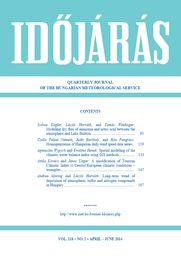IDŐJÁRÁS - angol nyelvű folyóirat
Vol. 118, No. 2 * Pages 93–191 * April – June 2014
 |
|
Modeling dry flux of ammonia and nitric acid between the atmosphere and Lake Balaton
Szilvia Kugler, László Horváth, and Tamás Weidinger
idojaras.2014.2.1 (p. 93–)
Szilvia Kugler, László Horváth, and Tamás Weidinger
idojaras.2014.2.1 (p. 93–)
Homogenization of Hungarian daily wind speed data series
Csilla Péliné Németh, Judit Bartholy, and Rita Pongrácz
idojaras.2014.2.2 (p. 119–)
Csilla Péliné Németh, Judit Bartholy, and Rita Pongrácz
idojaras.2014.2.2 (p. 119–)
Spatial modeling of the climatic water balance index using GIS methods
Agnieszka Wypych and Ewelina Henek
idojaras.2014.2.3 (p. 133–)
Agnieszka Wypych and Ewelina Henek
idojaras.2014.2.3 (p. 133–)
A modification of Tourism Climatic Index to Central European climatic conditions – examples
Attila Kovács and János Unger
idojaras.2014.2.4 (p. 147–)
Attila Kovács and János Unger
idojaras.2014.2.4 (p. 147–)
Long-term trend of deposition of atmospheric sulfur and nitrogen compounds in Hungary
Andrea Móring and László Horváth
idojaras.2014.2.5 (p. 167–)
Andrea Móring and László Horváth
idojaras.2014.2.5 (p. 167–)
IDŐJÁRÁS folyóirat

Az IDŐJÁRÁS a HungaroMet Nonprofit Zrt. negyedévenként megjelenő angol nyelvű folyóirata
Megrendelhető a journal.idojaras@met.hu címen.
A szerzőknek szánt útmutató itt olvasható.
Megrendelhető a journal.idojaras@met.hu címen.
A szerzőknek szánt útmutató itt olvasható.









